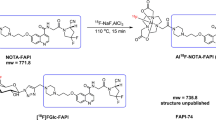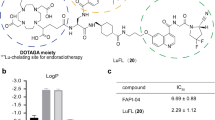Abstract
Purpose
Fibroblast activation protein (FAP) has become a promising cancer-related target for diagnosis and therapy. The aim of this study was to develop a bivalent FAP ligand for both diagnostic PET imaging and endoradiotherapy.
Methods
We synthesized a bivalent FAP ligand (ND-bisFAP) and labeled it with 18F or 177Lu. FAP-positive A549-FAP cells were used to study competitive binding to FAP, cellular internalization, and efflux properties in vitro. Micro-PET imaging with [18F]AlF-ND-bisFAPI was conducted in mice bearing A549-FAP or U87MG tumors. Biodistribution and therapeutic efficacy of [177Lu]Lu-ND-bisFAPI were conducted in mice bearing A549-FAP tumors.
Results
The FAP binding affinity of ND-bisFAPI is 0.25 ± 0.05 nM, eightfold higher in potency than the monomeric DOTA-FAPI-04 (IC50 = 2.0 ± 0.18 nM). In A549-FAP cells, ND-bisFAPI showed specific uptake, a high internalized fraction, and slow cellular efflux. Compared to the monomeric [18F]AlF-FAPI-42, micro-PET imaging with [18F]AlF-ND-bisFAPI showed higher specific tumor uptake and retention for at least 6 h. Biodistribution studies showed that [177Lu]Lu-ND-bisFAPI had higher tumor uptake than [177Lu]Lu-FAPI-04 at the 24, 72, 120, and 168 h time points (all P < 0.01). [177Lu]Lu-ND-bisFAPI delivered fourfold higher radiation than [177Lu]Lu-FAPI-04 to A549-FAP tumors. For the endoradiotherapy study, 37 MBq of [177Lu]Lu-ND-bisFAPI significantly reduced tumor growth compared to the same dose of [177Lu]Lu-FAPI-04. Half of the dose of [177Lu]Lu-ND-bisFAPI (18.5 MBq) has comparable median survival as 37 MBq of [177Lu]Lu-FAPI-04 (37 vs 36 days).
Conclusion
The novel bivalent FAP ligand was developed as a theranostic radiopharmaceutical and showed promising properties including higher tumor uptake and retention compared to the established radioligands [18F]AlF-FAPI-42 and [177Lu]Lu-FAPI-04. Preliminary experiments with 18F- or 177Lu-labeled ND-bisFAPI showed promising imaging properties and favorable anti-tumor responses.






Similar content being viewed by others
References
Scanlan MJ, Raj BKM, Calvo B, Garin-Chesa P, Sanz-Moncasi MP, Healey JH, et al. Molecular cloning of fibroblast activation protein α, a member of the serine protease family selectively expressed in stromal fibroblasts of epithelial cancers. Proc Natl Acad Sci U S A. 1994;91:5657–61.
Bušek P, Mal R, Šedo A. Dipeptidyl peptidase IV activity and/or structure homologues (DASH) and their substrates in cancer. Int J Biochem Cell Biol. 2004;36:408–21.
Šimková A, Bušek P, Šedo A, Konvalinka J. Molecular recognition of fibroblast activation protein for diagnostic and therapeutic applications. Biochim Biophys Acta Proteins Proteomics. 2020;1868(7):140409.
Busek P, Mateu R, Zubal M, Kotackova L, Sedo A. Targeting fibroblast activation protein in cancer–prospects and caveats. Front Biosci (Landmark Ed). 2018;23(10):1933–68.
Lindner T, Loktev A, Altmann A, Giesel F, Kratochwil C, Debus J, et al. Development of quinoline-based theranostic ligands for the targeting of fibroblast activation protein. J Nucl Med. 2018;59:1415–22.
Wang S, Zhou X, Xu X, Ding J, Liu S, Hou X, et al. Clinical translational evaluation of Al18F-NOTA-FAPI for fibroblast activation protein-targeted tumour imaging. Eur J Nucl Med Mol Imaging. 2021. https://doi.org/10.1007/s00259-021-05470-5.
Zhao L, Niu B, Fang J, Pang Y, Li S, Xie C, et al. Synthesis, preclinical evaluation, and a pilot clinical PET imaging study of 68Ga-labeled FAPI dimer. J Nucl Med. 2021. https://doi.org/10.2967/jnumed.121.263016.
Liu Y, Watabe T, Kaneda-Nakashima K, Shirakami Y, Naka S, Kazuhiro Ooe K, et al. Fibroblast activation protein targeted therapy using [177Lu]FAPI-46 compared with [225Ac]FAPI-46 in a pancreatic cancer model. Eur J Nucl Med Mol Imaging. 2021. https://doi.org/10.1007/s00259-021-05554-2.
Baum RP, Schuchardt C, Singh A, Chantadisai M, Robiller FC, Zhang J, et al. Feasibility, biodistribution and preliminary dosimetry in peptide-targeted radionuclide Therapy (PTRT) of diverse adenocarcinomas using 177Lu-FAP-2286: first-in-human results. J Nucl Med. 2021. https://doi.org/10.2967/jnumed.120.259192.
Xu M, Zhang P, Ding J, Chen J, Huo L, Liu Z. Albumin binder–conjugated fibroblast activation protein inhibitor radiopharmaceuticals for cancer therapy. J Nucl Med. 2021. https://doi.org/10.2967/jnumed.121.262533.
Wen X, Xu P, Shi M, Liu J, Zeng X, Zhang Y, et al. Evans blue-modified radiolabeled fibroblast activation protein inhibitor as long-acting cancer therapeutics. Theranostics. 2022;12:422–33.
Zhang P, Xu M, Ding J, Chen J, Zhang T, Huo L, et al. Fatty acid-conjugated radiopharmaceuticals for fibroblast activation protein-targeted radiotherapy. Eur J Nucl Med Mol Imaging. 2021. https://doi.org/10.1007/s00259-021-05591-x.
Ballal S, Yadav MP, Kramer V, Moon ES, Roesch F, Tripathi M, et al. A theranostic approach of [68Ga]Ga-DOTA.SA.FAPi PET/CT-guided [177Lu]Lu-DOTA.SA.FAPi radionuclide therapy in an end-stage breast cancer patient: new frontier in targeted radionuclide therapy. Eur J Nucl Med Mol Imaging. 2021;48:942–4.
Meyer C, Dahlbom M, Lindner T, Vauclin S, Mona C, Slavik R, et al. Radiation dosimetry and biodistribution of 68Ga-FAPI-46 PET imaging in cancer patients. J Nucl Med. 2020;61:1171–7.
Giesel FL, Adeberg S, Syed M, Lindner T, Jiménez-Franco LD, Mavriopoulou E, et al. FAPI-74 PET/CT using either 18F-AlF or cold-kit 68Ga labeling: biodistribution, radiation dosimetry, and tumor delineation in lung cancer patients. J Nucl Med. 2021;62:201–7.
Toms J, Kogler J, Maschauer S, Daniel C, Schmidkonz C, Kuwert T, et al. Targeting fibroblast activation protein: radiosynthesis and preclinical evaluation of an 18F-Labeled FAP inhibitor. J Nucl Med. 2020;61:1806–13.
Loktev A, Lindner T, Burger EM, Altmann A, Giesel F, Kratochwil C, et al. Development of fibroblast activation protein-targeted radiotracers with improved tumor retention. J Nucl Med. 2019;60:1421–9.
Loktev A, Lindner T, Mier W, Debus J, Altmann A, Jäger D, et al. A tumor-imaging method targeting cancer-associated fibroblasts. J Nucl Med. 2018;59:1423–9.
Kratochwil C, Flechsig P, Lindner T, Abderrahim L, Altmann A, Mier W, et al. 68Ga-FAPI PET/CT: tracer uptake in 28 different kinds of cancer. J Nucl Med. 2019;60:801–5.
Hu K, Wang L, Wu H, Huang S, Tian Y, Wang Q, et al. [18F]FAPI-42 PET imaging in cancer patients: optimal acquisition time, biodistribution, and comparison with [68Ga]Ga-FAPI-04. Eur J Nucl Med Mol Imaging. 2021. https://doi.org/10.1007/s00259-021-05646-z.
Hu K, Li J, Wang L, Huang Y, Li L, Ye S, et al. Preclinical evaluation and pilot clinical study of [18F]AlF-labeled FAPI-tracer for PET imaging of cancer associated fibroblasts. Acta Pharm Sin B. 2021. https://doi.org/10.1016/j.apsb.2021.09.032.
Chen H, Pang Y, Wu J, Zhao L, Hao B, Wu J, et al. Comparison of [68Ga]Ga-DOTA-FAPI-04 and [18F]FDG PET/CT for the diagnosis of primary and metastatic lesions in patients with various types of cancer. Eur J Nucl Med Mol Imaging. 2020;47:1820–32.
Wang H, Zhu W, Ren S, Kong Y, Huang Q, Zhao J, et al. 68Ga-FAPI-04 versus 18F-FDG PET/CT in the detection of hepatocellular carcinoma. Front Oncol. 2021;11:1–10.
Wang S, Zhou X, Xu X, Ding J, Liu T, Jiang J, et al. Dynamic PET/CT imaging of 68Ga-FAPI-04 in Chinese subjects. Front Oncol. 2021;11:1–11.
Shi X, Xing H, Yang X, Li F, Yao S, Zhang H, et al. Fibroblast imaging of hepatic carcinoma with 68Ga-FAPI-04 PET/CT: a pilot study in patients with suspected hepatic nodules. Eur J Nucl Med Mol Imaging. 2021;48:196–203.
Kuten J, Levine C, Shamni O, Pelles S, Wolf I, Lahat G, et al. Head-to-head comparison of [68Ga]Ga-FAPI-04 and [18F]FDG PET/CT in evaluating the extent of disease in gastric adenocarcinoma. Eur J Nucl Med Mol Imaging. 2021. https://doi.org/10.1007/s00259-021-05494-x.
Huang Y, Li H, Ye S, Tang G, Liang Y, Hu K. Synthesis and preclinical evaluation of an Al18F radio fluorinated bivalent PSMA ligand. Eur J Med Chem. 2021;221:113502. https://doi.org/10.1016/j.ejmech.2021.113502.
Lieberman BP, Ploessl K, Wang L, Qu W, Zha Z, Wise DR, et al. PET imaging of glutaminolysis in tumors by 18F-(2S,4R)4- fluoroglutamine. J Nucl Med. 2011;52:1947–55.
Spetz J, Rudqvist N, Forssell-Aronsson E. Biodistribution and dosimetry of free 211At, 125I- and 131I- in rats. Cancer Biother Radiopharm. 2013;28:657–64.
Yusufi N, Wurzer A, Herz M, D’Alessandria C, Feuerecker B, Weber W, et al. Comparative preclinical biodistribution, dosimetry, and endoradiotherapy in metastatic castration-resistant prostate cancer using 19F/177Lu-rhPSMA-7.3 and 177Lu-PSMA I&T. J Nucl Med. 2021;62:1106–11.
Lang L, Li W, Guo N, Ma Y, Zhu L, Kiesewetter DO, et al. Comparison study of [18F]FAl-NOTA-PRGD2, [18F]FPPRGD2, and [68Ga]Ga-NOTA-PRGD2 for PET imaging of U87MG tumors in mice. Bioconjug Chem. 2011;22:2415–22.
Zia NA, Cullinane C, Van Zuylekom JK, Waldeck K, McInnes LE, Buncic G, et al. A bivalent inhibitor of prostate specific membrane antigen radiolabeled with copper-64 with high tumor uptake and retention. Angew Chemie-Int Ed. 2019;58:14991–4.
Banerjee SR, Pullambhatla M, Shallal H, Lisok A, Mease RC, Pomper MG. A modular strategy to prepare multivalent inhibitors of prostate-specific membrane antigen (PSMA). Oncotarget. 2011;2:1244–53.
Tran E, Chinnasamy D, Yu Z, Morgan RA, Lee CCR, Restifo NP, et al. Immune targeting of fibroblast activation protein triggers recognition of multipotent bone marrow stromal cells and cachexia. J Exp Med. 2013;210:1065–8.
Funding
This work was supported in part by the National Natural Science Foundation of China (81860315, 81802250), Guangdong Basic and Applied Basic Research Foundation (2021A1515011099, 2020A1515011014), Outstanding Youths Development Scheme of Nanfang Hospital, Southern Medical University (2017J010), and GDMPA Key Laboratory for Quality Control and Evaluation of Radiopharmaceuticals (2021ZDB02).
Author information
Authors and Affiliations
Contributions
Study conception and design, Kongzhen Hu; acquiring data, Shimin Ye, Hongsheng Li, Li Li, Jiawei Zhong, and Qingsong Yan; analysis and interpretation of data, Kongzhen Hu, Hongsheng Li, Shimin Ye, Yuhua Zhong, and Pengju Feng; data management, Shimin Ye; drafting the manuscript, Hongsheng Li and Shimin Ye; revising the manuscript, Kongzhen Hu.
Corresponding author
Ethics declarations
Ethics approval
All animal experiments were performed in compliance with the legislation on the use of laboratory animals and approved by Nanfang Hospital Animal Ethics Committee at the Southern Medical University, China (Application No: NFYY-2020–1209).
Consent for publication
All authors approved the article for publication.
Conflict of interest
The authors declare no competing interests.
Additional information
Publisher’s note
Springer Nature remains neutral with regard to jurisdictional claims in published maps and institutional affiliations.
This article is part of the Topical Collection on Theragnostic
Supplementary Information
Below is the link to the electronic supplementary material.
Rights and permissions
About this article
Cite this article
Li, H., Ye, S., Li Li et al. 18F- or 177Lu-labeled bivalent ligand of fibroblast activation protein with high tumor uptake and retention. Eur J Nucl Med Mol Imaging 49, 2705–2715 (2022). https://doi.org/10.1007/s00259-022-05757-1
Received:
Accepted:
Published:
Issue Date:
DOI: https://doi.org/10.1007/s00259-022-05757-1




